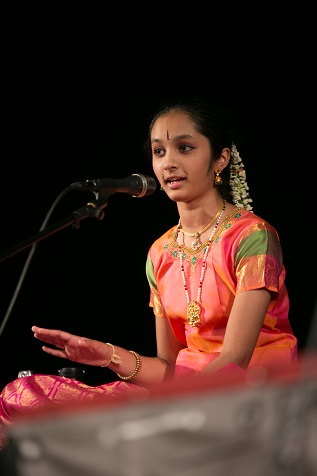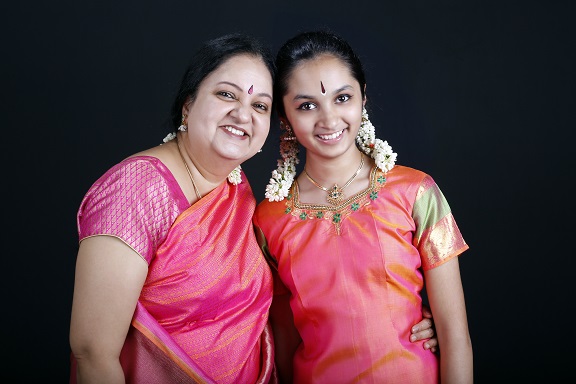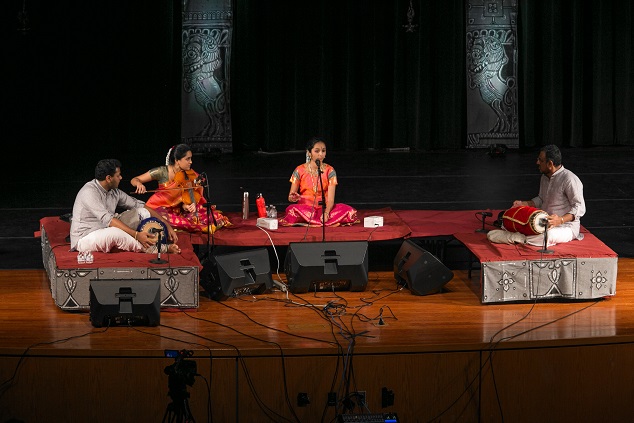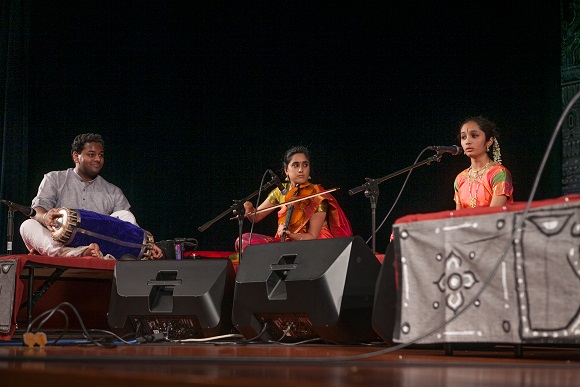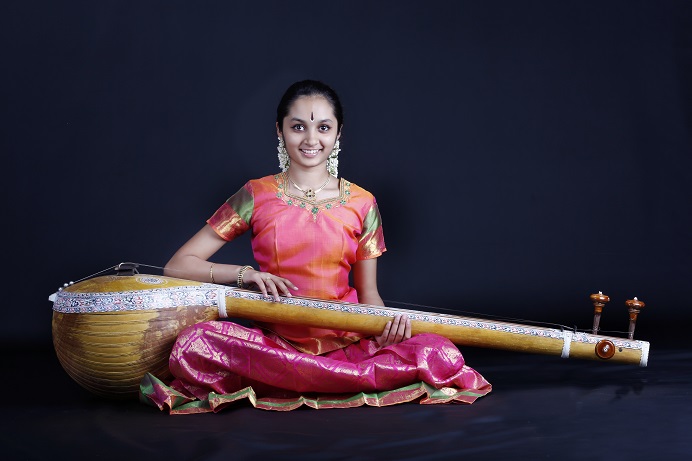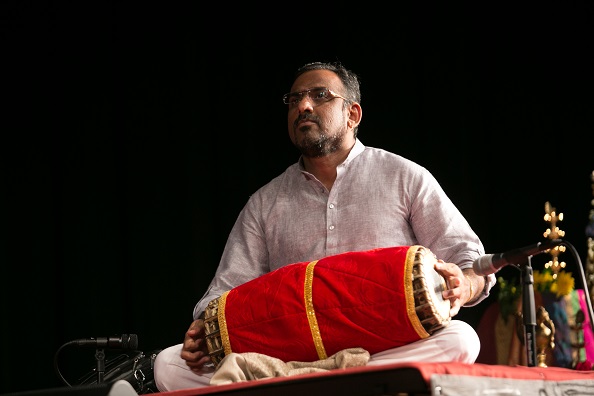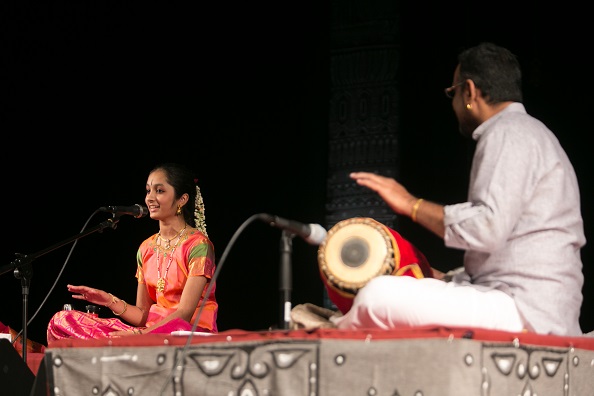Contribute
| Carnatic Vocal Arangetram: Amrita Ajai Thirumalai |
Janani Swamy and Rayadurgam Ravikanth
09/14/2017
On August 26th, 2017, 14-year-old Amrita Ajai Thirumalai, student of renowned Guru Smt. Tara Anand of the Anubhava School of Music presented her Carnatic vocal arangetram at the Worcester Technical High School in Worcester, MA. Amrita was accompanied on the violin by Sahana Srinivasan, a senior disciple of Guru Tara and on the mridangam by Vidwan Sri K.U. Jayachandra Rao and Tarun Bangalore. Amrita presented a 4-hour concert of the elite standard we have come to expect from the Anubhava school. I can stake the unique claim of having been present for Amrita’s very first lesson at Anubhava. I remember being struck by the certainty with which a little Amrita rattled off one Sarali varusai after another – each note in perfect position. As I think back to that first lesson, it really is no surprise at all that Amrita has become a young musician for whom music is as natural as breath. In her opening remarks, Guru Tara reflected on the Arangetram being much more than a maiden concert – as a rebirth of the shishya that comes after years of endless work, immersion in the art form and a deep internalization of music. Guru Tara described her disciple Amrita as “very accomplished…gifted with copious talent…a tremendous voice…razor sharp memory…. effortless improvisation…brilliant ability to organize musical details…explosive growth as a musician in the past six months…artistry that belies her ageâ€. In the 4 hours that followed, Amrita’s music left us with no question as to the accuracy of her Guru’s description! The tremendous capability of her voice was evident from the opening lines of the Ata tala varnam “Chalamelaâ€. Amrita rendered the first half of the varnam flawlessly in four speeds with absolute conviction in each note and gamakam. Variations in the charanam line “Papajathi Marulu†showcased Amrita’s superlative ease with brighas as she flew all over Shankarabaranam. Next was “Sri Vathapi Ganapathiyeâ€, a composition of Sri Papanasam Sivan in ragam Sahana. Amrita rendered this piece at just the right tempo and with the timbre of her voice capturing the essence of the ragam. The exchange of swarams between Amrita and violinist Sahana created a pretty picture that was especially interesting for variations in the starting and end points. This was followed by a powerful rendition of the beautiful Mutthuswami Dikshithar composition “Rangapura Viharaâ€. Amrita’s keen musical instinct was evident in her just-right treatment of this piece in Brindavana Saranga. Amrita then presented the first of the main pieces of the evening, Saint Thyagaraja’s “Koluva Maragadha Kodandapani†in Thodi. Picture Amrita’s Thodi as a brilliant landscape – flashes of brighas, waves of gamakams – gentle and roiling, and a downpour of phrases and swarams. The ideas and phrases that poured out during the Alapanai, especially in madhyama kala and the shruthi bhedam in Mohanakalyani, could only have come from a deep internalization of the ragam. The alapanai, matched to the krithi, focused on the upper octave where Amrita sang with ease – as if the upper panchamam were the most natural place to expound. The krithi itself was a display of the classicism of the Anubhava Paddhathi. The grandeur of the composition, rendered in the classicism of the Anubhava Paddhathi, was brought out in its full glory, with the beautifully enunciated sangathis highlighting the lyrics of the Saint. In the neraval at “Sri Karunikaashritha Chintamanuniki†and swarams that followed, Amrita fearlessly explored the Thodi right up to its very edges. A lilting rendition of “Manavyala kincharaâ€, a composition of Saint Thyagaraja in Nalinakanti followed. Amrita presented “Ninnuvinaga Mari Dikkevaruâ€, a seldom heard composition of Subbaraya Shastri in Poorvi Kalyani, as the main piece. Her interpretation of Poorvi Kalyani in the alapanai was one that came from a gnanam that catapults the ordinary to a different level. Amrita’s alapanais bring together a richness, flow and majesty, akin to the nadaswara bani; no mean feat for a young musician to pull off! The krithi was rendered at an impactful chowka meter. In the neraval at “Paramalo bhulanu pogadi aani†and the swarams that followed, Amrita knew when exactly to use “azhutthamâ€, when to pull back into softness and how to modulate to achieve the range in between. Sahana’s melodies enriched and enhanced Amrita’s presentation. A Carnatic music concert is at its finest when melody and rhythm mesh together seamlessly. Vidwan Sri Jayachandra Rao and his talented student Tarun Bangalore on the mridangam, with their obvious chemistry, complemented each other beautifully and elevated the concert with their robust and sensitive accompaniment. This was a shining example of how the concert as a whole exceeded the sum of the parts. The Thani Avarthanam in Viloma Chapu after the Purvi Kalyani composition was a delight to hear with myriad rhythmic combinations and a balanced use of the bass and treble of the mridangam. Even as they displayed complete virtuosity through masterly execution of various nadais and the koraippu in particular, the true caliber shone through in how they captured the imagination of the audience which was clearly awestruck by their performance. A lively rendition of “Paridhana Meechiteâ€, a composition of Patnam Subramanya Iyer, in the ragam Bilahari followed. An interesting effect was the rendition of the charanam at a faster tempo. Amrita then presented the Ragam-Thanam-Pallavi in Charukeshi. The alapanai in Charukeshi was followed by a brilliant Thanam which Amrita built up with escalating speed to a flawless crescendo at the upper octave. Sahana’s response to the alapana and the tanam was equally brilliant, bringing out the beauty of Charukesi in a concise fashion. The Pallavi, “Velanai, Shiva Balanai, Varaguna Sheelanai, Nee Ninai Manameâ€, a composition of Maha Vidwan Sri T. R. Subramanyam in Kanda Jathi Triputa Thalam, was replete with the bhavam of Charukeshi. In the neraval, trikalam and the swarams Amrita displayed precise mastery of layam as she negotiated changes in kalam and nadai with ease. In particular, Amrita sang swarams in many challenging speeds and nadais without sacrificing the raga bhava and aesthetics. Amrita ended the RTP with dazzling ragamalika swarams and korvai. The RTP was crowned with a delightful short thani by Guru J.C. Sir and Tarun. In the Thukkada pieces that followed, Amrita demonstrated great versatility by creating a different musical impact. While she handled the main pieces with weighty classicism, in the thukkadas, Amrita conveyed the bhava and emotive power of lighter ragas such as Madhuvanthi, Bageshwari, Desh and Shiva Ranjani. Amrita concluded her recital with a Thillana in Sindhu Bhairavi, a composition of the late Maestro Sri Lalgudi Jayaraman and a Gujarathi Bhajan by Narasinh Mehta. Throughout the recital, the rapport between Amrita and the orchestra team was palpable. We have watched Sahana evolve to a place where she is able to tailor her playing and sensitivities to match that of the main artiste. She did this with Amrita as she thoroughly fulfilled her role as accompanist and Amrita’s musical partner, playing with the right balance of dazzle and restraint. J. C. Sir encouraged Amrita throughout the recital with a smile on his face, taking such joy in a debut recital despite being such a Senior Vidwan. It was a joy to watch him and Tarun play in tandem – who would have thought two mridangams could have such perfect reverberation and nadham? The recital concluded with reflections from the Chief Guest for the evening, eminent musician and musicologist Smt. Sujatha Vijayaraghavan. Smt. Sujatha was so right in saying we are extraordinarily fortunate to have Guru Tara amidst us – a Guru of immense caliber who keeps raising the bar, imparting strength and power to her disciples, each of whom she challenges to their fullest potential. Smt. Sujatha congratulated Amrita for having accomplished nothing short of a feat – delivering a concert of such melodic and rhythmic complexity completely unfazed. As Smt. Sujatha Vijayaraghavan noted, the art of music is wealth that keeps growing as it is gifted – and under Guru Tara’s care, Amrita’s tremendous music is sure to grow to give her, and all of us, immense joy.
You may also access this article through our web-site http://www.lokvani.com/
